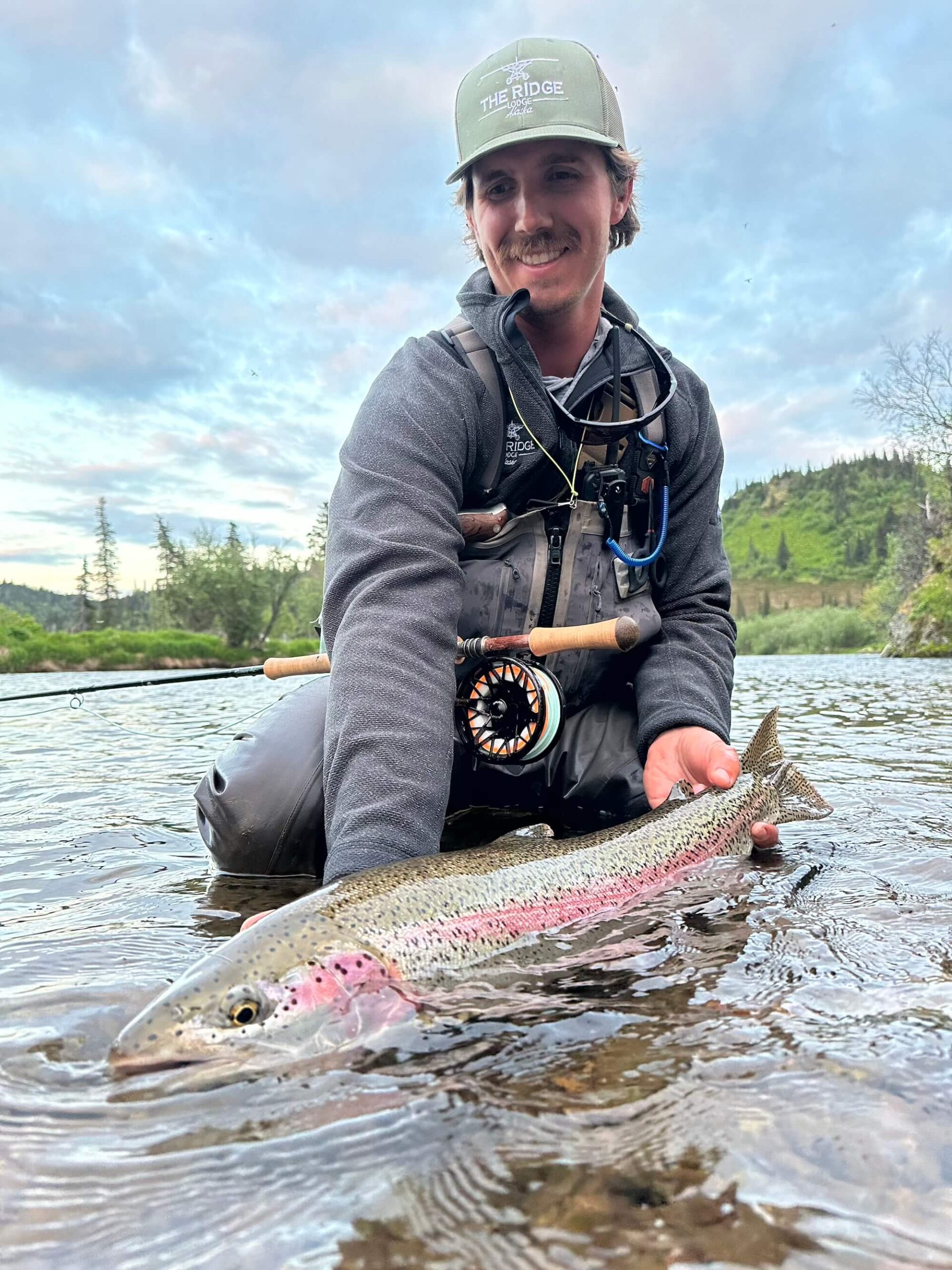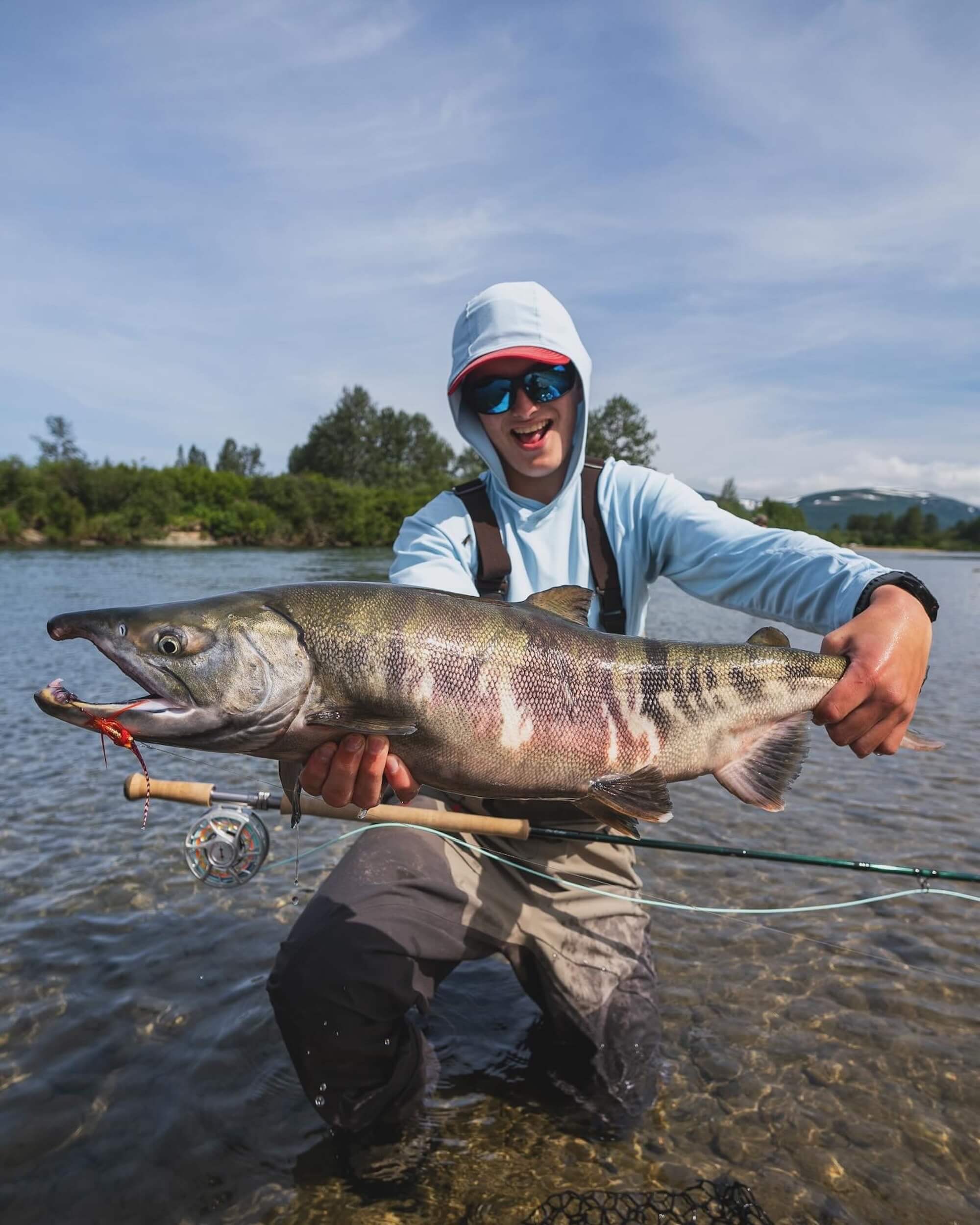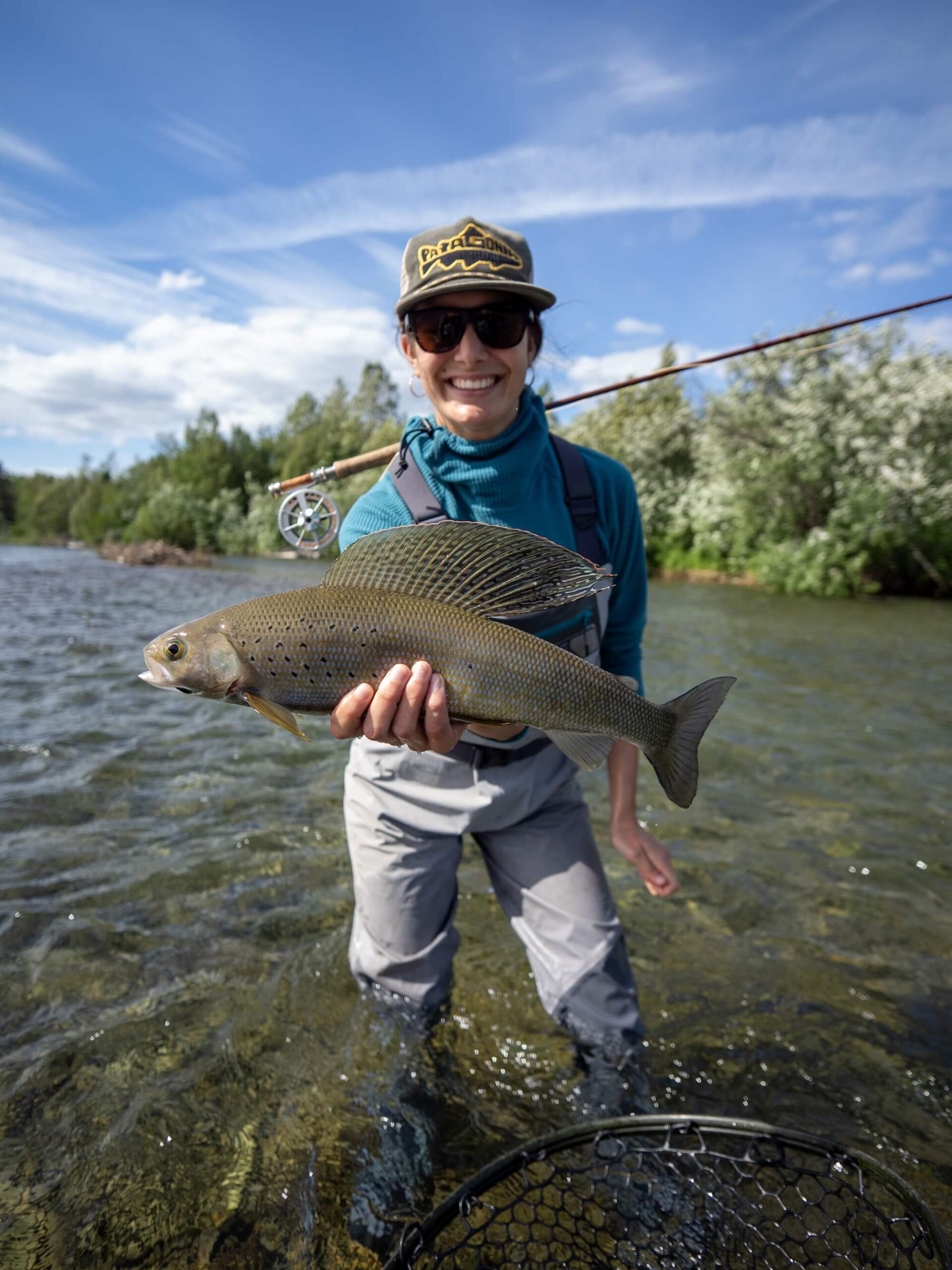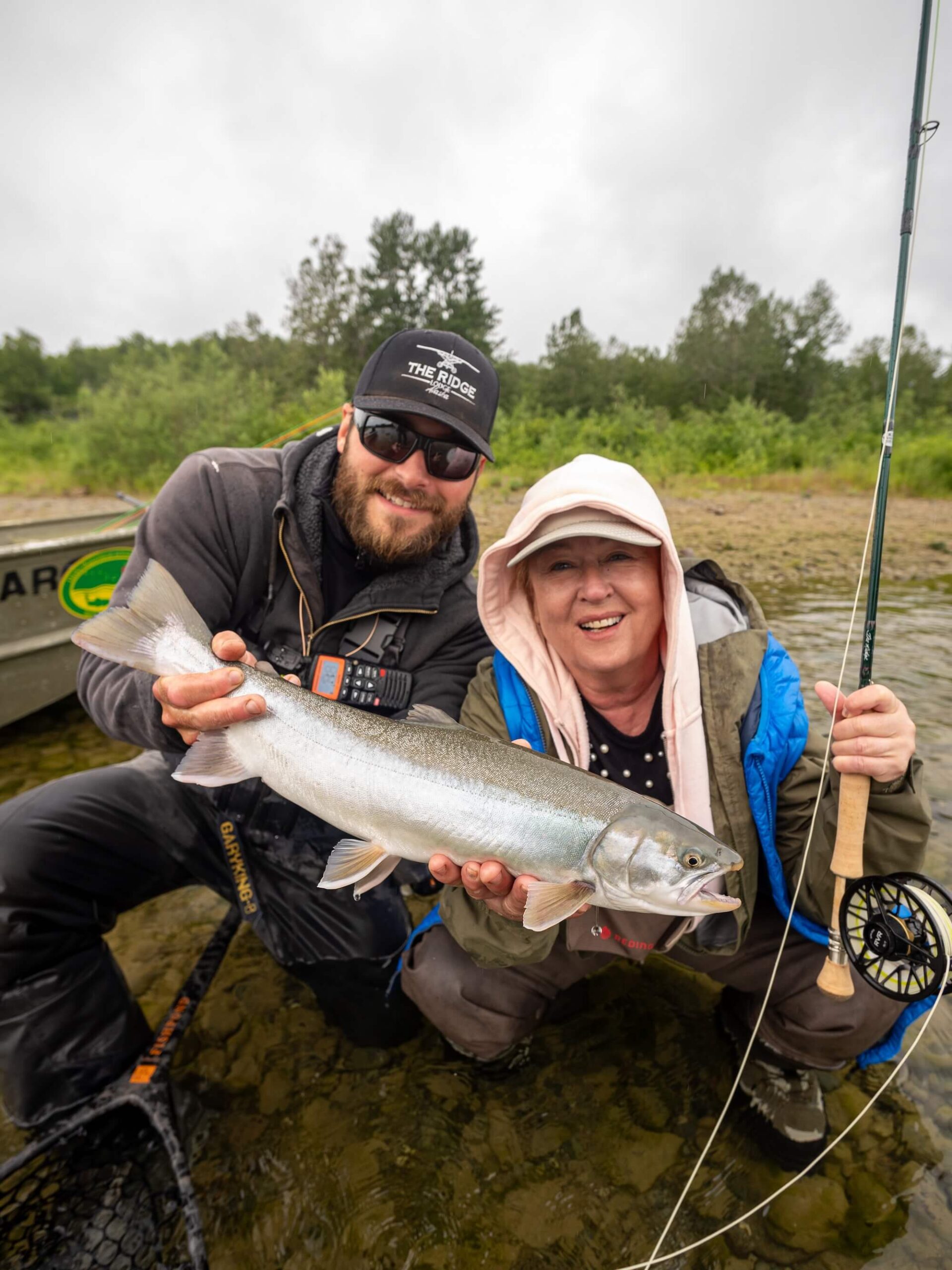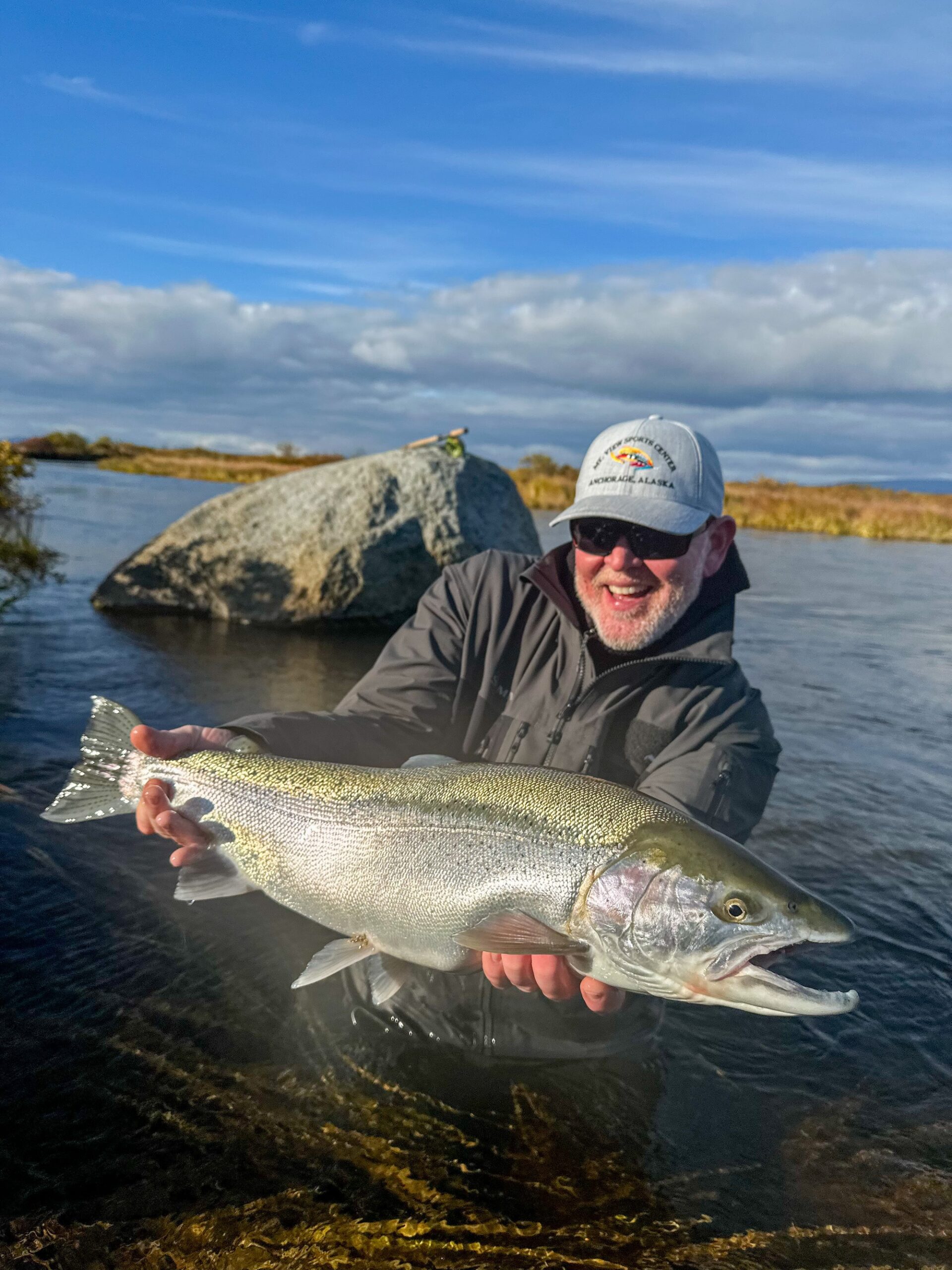Same Lodge, Different Experiences
June through mid-October—no two weeks are the same.Early Season: June & first half of July
Fishing opens on June 8th. After trout spend the winter under ice, without seeing artificial flies since the previous October, June 8th means GAME ON for fly fishermen.
Prior to the arrival of the sockeye salmon, trout feed on a diversity of available food sources. An abundance of aquatic insects on rivers like the Copper and Gibraltar makes nymph fishing very effective, and dry fly action is remarkably consistent. Warming Springtime water temps activate a massive hatch and out-migration of sockeye salmon fry. Resident sculpins and anadromous lamprey eels also contribute to a very productive streamer bite in June and July. Larger outlet rivers host a migration of salmon smolt on their way to the Ocean- big rainbows and lake trout stack up year after year to take advantage.
Whether fly fishing large rivers such as the Kvichak or small/medium rivers like the Copper, Spey rods are an excellent tool for covering water in June and July. First timers consistently cast large streamers and heavy sink tips at distance with ease after just 45 minutes of instruction. Many guests have asked what spey rod to purchase after their trip with us… It’s always an easy answer: “Get yourself an R.L. Winston!”
Northern Pike and arctic grayling fly fishing action peaks in June and July as well. Dry fly fishing for grayling and streamer fishing for pike are some of the most action-packed fishing experiences in Alaska. In additon to trout, these species make for a diverse week of fly fishing during the eaerly season.
Early Season: June & Early July
Fishing opens on June 8th. After trout spend the winter under ice, without seeing artificial flies since the previous October, June 8th means GAME ON for fly fishermen.
Prior to the arrival of the sockeye salmon, trout feed on a diversity of available food sources. An abundance of aquatic insects on rivers like the Copper and Gibraltar makes nymph fishing very effective, and dry fly action is remarkably consistent. Warming Springtime water temps activate a massive hatch and out-migration of sockeye salmon fry. Resident sculpins and anadromous lamprey eels also contribute to a very productive streamer bite in June and July. Larger outlet rivers host a migration of salmon smolt on their way to the Ocean- big rainbows and lake trout stack up year after year to take advantage.
Whether fly fishing large rivers such as the Kvichak or small/medium rivers like the Copper, Spey rods are an excellent tool for covering water in June and July. First timers consistently cast large streamers and heavy sink tips at distance with ease after just 45 minutes of instruction. Many guests have asked what spey rod to purchase after their trip with us… It’s always an easy answer: “Get yourself an R.L. Winston!”
Northern Pike and arctic grayling action peaks in June and July as well. Dry fly fishing for grayling and streamer fishing for pike are some of the most action-packed fishing experiences in Alaska. In additon to trout, these species make for a diverse week of fly fishing during the early season.

Salmon Invasion: July

Each July, the Bristol Bay watershed receives the largest transfer of nutrients from one habitat to another. Returning from the Pacific Ocean to their natal streams, sockeye salmon file in by the literal millions. In 2022, Bristol Bay had a record-breaking salmon run of 78 million fish and has averaged over 48 million for the past 20 years. These hard-fighting sockeyes are fresh from the Ocean, chrome-bright, and plentifiul. The Copper is an ideal river to fly fish for sockeyes during their run. Its clear water and shallow gravel bars make for great sight-casting. Anglers can keep a limit of 5 sockeyes per person, per day.
With the arrival of the salmon, bear-viewing begins. Our backyard has one of the highest concentrations of brown bears on the planet. Watching bears fish for sockeyes in a natural wonder. Spoiler alert: flies imitating salmon flesh will begin working at this time of the season- the bears’ scraps don’t go unnoticed by opportunistic rainbow trout.
Chum, pink salmon, and sea-run dolly varden begin entering Katmai National Park’s coastal streams during the second half of July.
July is the best month for fly fishing a diversity of species, and for bringing fish home. (note: rainbow trout are regulation catch and release only)

Salmon Invasion: July
Each July, the Bristol Bay watershed receives the largest transfer of nutrients from one habitat to another. Returning from the Pacific Ocean to their natal streams, sockeye salmon file in by the literal millions. In 2022, Bristol Bay had a record-breaking salmon run of 78 million fish and has averaged over 48 million for the past 20 years. These hard-fighting sockeyes are fresh from the Ocean, chrome-bright, and plentifiul. The Copper is an ideal river to fly fish for sockeyes during their run. Its clear water and shallow gravel bars make for great sight-casting. Anglers can keep a limit of 5 sockeyes per person, per day.
With the arrival of the salmon, bear-viewing begins. Our backyard has one of the highest concentrations of brown bears on the planet. Watching bears fish for sockeyes in a natural wonder. Spoiler alert: flies imitating salmon flesh will begin working at this time of the season- the bears’ scraps don’t go unnoticed by opportunistic rainbow trout.
Chum, pink salmon, and sea-run dolly varden begin entering Katmai National Park’s coastal streams during the second half of July.
July is the best month for fly fishing for a diversity of species, and for bringing fish home. (Note: rainbow trout are regulation catch and release only.)
Beads & Cohos: August / September
As the sockeye salmon pair up and begin to spawn in late July, the Fall feast begins. Over the next 6 weeks, our local rainbow trout will feed heavily on salmon eggs, which make up an estimated 20 to 60% of their annual diet. With plastic beads of various size and color drifted under a bobber, we effectively imitate these free-drifting salmon roe. The fly fishing experience is spectacular. Rainbow trout become very bold this time of year and are known to set up directly downstream of spawning sockeye pairs on shallow gravel. Regularly sight-casting to 24-28″+ rainbow trout for a full week will spoil you rotten.
On coastal rivers a short flight away, the opportunity to fly fish for fresh chum and pink salmon will continue into August. These salmon will gradually become less prevalent as the next run of salmon arrives…
Anglers coming in late August and early September also have an opportunity to fly fish for Coho salmon (aka “silvers”) on one of our favorite coastal rivers. Our guests enjoy catching these aggressive fish when they come in fresh from the Ocean. Catch and release, or keep your limit to bring home with you. (Daily bag limit is typically 3 fish per person)
Opportunities to fly fish for dolly varden, Arctic char, pike, and grayling will continue in August and September.
Bead Fishing & Cohos: August / September
.As the sockeye salmon pair up and begin to spawn in late July, the Fall feast begins. Over the next 6 weeks, our local rainbow trout will feed heavily on salmon eggs, which make up an estimated 20 to 60% of their annual diet. With plastic beads of various size and color drifted under a bobber, we effectively imitate these free-drifting salmon roe. The fly fishing experience is spectacular. Rainbow trout become very bold this time of year and are known to set up directly downstream of spawning sockeye pairs on shallow gravel. Regularly sight-casting to 24-28″+ rainbow trout for a full week will spoil you rotten.
On coastal rivers a short flight away, the opportunity to fly fish for fresh chum and pink salmon will continue into August. These salmon will gradually become less prevalent as the next run of salmon arrives…
Anglers coming in late August and early September also have an opportunity to fly fish for coho salmon (aka “silvers”) on one of our favorite coastal rivers. Our guests enjoy catching these aggressive fish when they come in fresh from the Ocean. Catch and release, or keep your limit to bring home with you. (Daily bag limit is typically 3 fish per person)
Opportunities to fly fish for dolly varden, Arctic char, pike, and grayling will continue in August and September.
Trophy Spey: Late September-Mid October
The leaves glow gold with the colors of Fall as the days become rapidly shorter. The landscape is changing, and so is our fly fishing strategy. By this point in the season, the trout will have spent the previous six weeks eating salmon eggs and packing on the pounds. After weeks of dead-drifting beads under indicators, we are thrilled at the thought of swinging streamers again for heavy late-season rainbows to wrap up the season. Through the very end, trout will eat beads, flesh flies, and streamers, but a portion of our late-season guests prefer to fish streamers on Spey rods exclusively.
Though nearly all of the sockeyes have died off by mid-September, there are still some eggs around and bead fishing will definitely produce. However, with winter approaching, and eggs tapering off the menu, trout will begin feeding on chunks of dead salmon flesh, leeches, and sculpins more readily than in weeks prior.
For fly fishermen interested in the largest fish of the season, the late season presents a real opportunity to hunt for trophy trout. The purists’ form is to swing flies on a two-handed rod, for good reason. All of our fly fishing guides and many of our return guests will confidently say that Spey fishing is the most enjoyable & rewarding way to get ’em in the Spring & Fall.
Trophy Spey: Late September – Mid-October
The leaves glow gold with the colors of Fall as the days become rapidly shorter. The landscape is changing, and so is our fly fishing strategy. By this point in the season, the trout will have spent the previous six weeks eating salmon eggs and packing on the pounds. After weeks of dead-drifting beads under indicators, we are thrilled at the thought of swinging streamers again for heavy late-season rainbows to wrap up the season. Through the very end, trout will eat beads, flesh flies, and streamers, but a portion of our late-season guests prefer to fish streamers on Spey rods exclusively.
Though nearly all of the sockeyes have died off by mid-September, there are still some eggs around and bead fishing will definitely produce. However, with winter approaching, and eggs tapering off the menu, trout will begin feeding on chunks of dead salmon flesh, leeches, and sculpins more readily than in weeks prior.
For fly fishermen interested in the largest fish of the season, the late season presents a real opportunity to hunt for trophy trout. The purists’ form is to swing flies on a two-handed rod, for good reason. All of our guides and many of our return guests will confidently say that Spey fishing is the most enjoyable & rewarding way to get ’em in the Spring & Fall.



